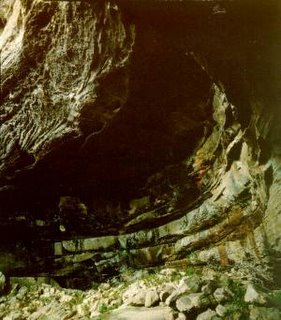Looting at Big South Fork National River and Recreation Area

Image: Rock Shelters or Rock Houses as they are sometimes called were at different times used as shelter by Native Americans, as homes, schools or animal pens by early settlers and even as sites for moonshine stills by later entrepreneurs.
The Big South Fork National River and Recreation Area is located in north central Tennessee and southeastern Kentucky in some of the most rugged terrain of the Cumberland Plateau. Big South Fork encompasses approximately 125,000 acres of both rugged forested gorge and adjacent forested plateaus. State and federal lands share the north and western boundary, offering a variety of habitats for both plants and animals. Within the Area many pristine streams, both in Tennessee and Kentucky flow into the free-flowing Big South Fork of the Cumberland River. Deep gorges carved by eons of erosion have created impressive cliffs and arches throughout the National Area.
To the trained eyes of the archaeological team, evidence of their occupation was everywhere. Scattered on the ground were the remains of spear and arrow points, a baseball-size rock the prehistoric hunters and gatherers had used as a hammer stone, and pieces of flint used to scrape animal hides.
As Tom Des Jean, an archaeologist for the Big South Fork National River and Recreation Area, explained, the team was picking through artifacts looters had left behind.
"Probably 40 percent of the rock shelters that are archaeological sites in this park have experienced looting from people looking for Native American relics," Des Jean said. "Most people don't comprehend the loss of information when you dig up one of these sites. They are an irreplaceable part of our American heritage."
While looting and gratuitous damage is executed in too many of our National parks across the country, perhaps no where is of greater importance than in the Big South Fork simply because of the latitude of archaeological sites, Native American artifacts, historical and cultural significance of the area.
Located on the Cumberland Plateau in Tennessee and Kentucky, the park contains 1,338 documented archaeological sites -- more than in any other national park in the Southeast. By comparison, the Great Smoky Mountains National Park, which is almost five times bigger than Big South Fork, includes 450 known archaeological sites.
What are these looters getting for their trouble? Well if caught this is what they get:
Archaeological resources on public lands are protected under federal law. In the summer of 2004, backcountry rangers with the Big South Fork caught two men red-handed while they were digging and removing artifacts from one of the park's rock shelters. The men, both from Pulaski County, were arrested and fined $3,198.09 under the Archaeological Resources Protection Act.
"All they got was a few points worth $5 or $6 apiece," Des Jean said. "Their entire take was only $120."
And, you can see what they would have made off with if they hadn’t got caught; $120.00 total.
When you go into our National Parks, National Forest and other public lands PLEASE, leave nothing but footprints and take nothing but pictures and wonderful memories!
You can read the article that the excerpts quoted above were taken from here.
Technorati Tags: [Blue Ridge][Big South Fork][archaeological sites][Native American][National Parks][Tennessee][Kentucky][Great Smoky Mountains][University of Tennessee][Cumberland Plateau][American heritage]












0 Comments:
Post a Comment
<< Home